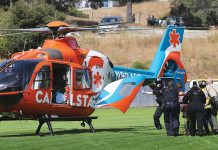SANTA CRUZ — Santa Cruz County will join a task force focused on alleviating noise from jets flying over the central part of the county, the Board of Supervisors decided Tuesday.
The supervisors also agreed to spend from $25,000 to $42,000 to join the Santa Clara/Santa Cruz County Airport/Community Roundtable, a cost that changes depending on how many jurisdictions join.
Capitola, Watsonville, Scotts Valley and Santa Cruz have also been invited to join, as have the jurisdictions of Santa Clara County, San Francisco Airport, Minéta San José Airport and the Federal Aviation Administration.
The group is modeled after a similar one at San Francisco International Airport.
Also as part of the decision, the supervisors appointed County Administrative Officer Carlos Palacios or a county representative to represent the county on the roundtable.
Under the agreement, the county will join the roundtable, with an evaluation after one year by the County Administrative Office.
Finally, the county will work to alleviate the impact of jet noise without moving the route to other parts of the county.
Noise from air traffic has been a problem for thousands of county residents since March 2015, when the Federal Aviation Administration changed a route that flew over Santa Cruz’s Westside and the San Lorenzo Valley, which was known as the “Big Sur” route.
The new route, known as SERFR, directs planes coming in over the ocean to cross over the Capitola Wharf and then the Santa Cruz Mountains before flying over Palo Alto, Menlo Park and East Palo Alto before heading north to San Francisco International Airport.
But under the rules of that route, even using idle power descent to reduce noise — a procedure known as optimal descent profile — does not abate the noise from the giant airliners descending overhead.
County residents, particularly ones who live in higher elevations in the mountains, have complained about jet noise that wakes them up at night, rattles their windows and forces them inside to avoid the noise.
Supervisor John Leopold said that the FAA has received an average of 6,000 complaints per day over a six-day period, which he called “low numbers.”
“It’s a nondiscriminatory effect,” Leopold said. “It affects the most vulnerable in our community.”
Christine Green, who lives near the summit, said she moved to the Santa Cruz Mountains in 1980, when it was a peaceful community. She said the noise since March 2015 makes living there untenable.
“Now it’s a nightmare, day and night,” she said.
A 12-member congressional subcommittee formed to address the issue later voted 8-4 to ask the FAA to move the flight path back to the Big Sur route. The FAA has said that change is not an option.
But even as the supervisors approved the plan to form the roundtable, they also expressed concern that it will lack the authority to affect change on a federal level.
In a Sept. 16 opinion article, a group composed of county lawmakers from several jurisdictions stressed that the FAA sets flight paths, and that congress has oversight.
“…the jurisdictions and the public can only communicate with the FAA, not direct its actions,” the piece read. “The FAA may attend roundtable meetings, but it is under no obligation to follow, let alone respond to, any roundtable action.”
Still, the supervisors largely agreed that the roundtable would give residents a voice in the ongoing issue.
What generated the most controversy among both supervisors and the public was who would represent the county on the roundtable.
A majority of speakers who lined up to address the supervisors for more than two hours requested that they appoint Leopold, who has been at the forefront of the issue and who said he has extensively studied the surprisingly complicated and technical aspects of flight paths.
But other supervisors disagreed, some expressing concern that an appointed supervisor would be more beholden to their own constituents than those in the rest of the county.
“There is no way that (Leopold) can be a fair representative for the entire community,” Supervisor Ryan Coonerty said. “If I had hundreds of constituents crying and demanding action, I couldn’t be a fair representative for this entire county.”
Leopold disagreed.
“I don’t think (staff) is the right ones to do this,” he said. “I think when you’re advocating with other elected officials your most powerful advocate is another elected official.”
Leopold said that appointing Palacios would be turning the seat over to a “bureaucrat.”
“I think the unincorporated residents need a strong advocate, and I am prepared to be a strong advocate,” Leopold said.
He also pointed out that the current bylaws of the roundtable state that only elected officials may vote on it, but other supervisors said this rule is likely to change.












